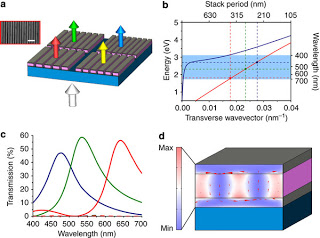Ad Support : Nano Technology Netbook Technology News Computer Software
(a) Schematic diagram of the proposed plasmonic nanoresonators. The white arrow represents the incident white light and the red, yellow, green and blue arrows represent the transmitted coloured light from the different stack arrays. Grey, pink and blue in the structure indicate the material of aluminium, zinc selenide and magnesium fluoride respectively. Inset is the scanning electron microscopy image of the fabricated device. Scale bar, 1 μm. (b) Plasmon dispersions in MIM stack array. Red, green and blue dots correspond to the case of filtering primary RGB colours. Red and blue curves correspond to antisymmetric and symmetric modes respectively. The shaded region indicates the visible range. (c) Simulated transmission spectra for the RGB filters. The solid and dash curves correspond to TM and TE illuminations respectively. The stack period for RGB filters is 360, 270 and 230 nm. (d) Cross-section of the time-average magnetic field intensity and electric displacement distribution (red arrow) inside the MIM stack at a wavelength of 650 nm with 360 nm stack period. The colours on the right side represent the constitutive materials, defined as in a
A University of Michigan professor has developed a new type of color filter made of nano-thin sheets of metal with precisely spaced gratings.
The pixels in Guo’s displays are about an order of magnitude smaller than those on a typical computer screen. They’re about eight times smaller than the pixels on the iPhone 4, which are about 78 microns. He envisions that this pixel size could make this technology useful in projection displays, as well as wearable, bendable or extremely compact displays. They are also simpler to make and more efficient.
Colour and spectral imaging systems typically use filters and glass prisms to disperse light of different wavelengths. With the miniaturization of integrated devices, current research on imaging sensors focuses on novel designs aiming at high efficiency, low power consumption and slim dimension, which poses great challenges to the traditional colourant-based filtering and prism-based spectral splitting techniques. In this context, surface plasmon-based nanostructures are attractive due to their small dimensions and the ability to efficiently manipulate light. In this article we use selective conversion between free-space waves and spatially confined modes in plasmonic nanoresonators formed by subwavelength metal–insulator–metal stack arrays to show that the transmission spectra through such arrays can be well controlled by using simple design rules, and high-efficiency colour filters capable of transmitting arbitrary colours can be achieved. These artificial nanostructures provide an approach for high spatial resolution colour filtering and spectral imaging with extremely compact device architectures.
(a) Optical microscopy images of seven plasmonic colour filters illuminated by white light. Scale bar, 10 μm. (b) Experimentally measured transmission spectra of three fabricated colour filters corresponding to the RGB colours. The circle and triangle correspond to TM and TE illuminations respectively. (c) Scanning electron microscopy image of the pattern ‘M’ formed by two stack periods. The periods of the navy blue background and the yellow character are 220 and 310 nm, respectively. Scale bar, 3 μm. (d) Optical microscopy image of the pattern illuminated with white light.
Conventional LCDs, or liquid crystal displays, are inefficient and manufacturing-intensive to produce. Only about 5 percent of their back-light travels through them and reaches our eyes, Guo said. They contain two layers of polarizers, a color filter sheet, and two layers of electrode-laced glass in addition to the liquid crystal layer. Chemical colorants for red, green and blue pixel components must be patterned in different regions on the screen in separate steps.
Guo’s color filter acts as a polarizer simultaneously, eliminating the need for additional polarizer layers. In Guo’s displays, reflected light could be recycled to save much of the light that would otherwise be wasted.Because these new displays contain fewer layers, they would be simpler to manufacture, Guo said. The new color filters contain just three layers: two metal sheets sandwiching a dielectric. Red, green and blue pixel components could be made in one step by cutting arrays of slits in the stack. This structure is also more robust and can endure higher- powered light.
Red light emanates from slits set around 360 nanometers apart; green from those about 270 nanometers apart and blue from those approximately 225 nanometers apart. The differently spaced gratings essentially catch different wavelengths of light and resonantly transmit through the stacks.“Amazingly, we found that even a few slits can already produce well-defined color, which shows its potential for extremely high-resolution display and spectral imaging,” Guo said.
If you liked this article, please give it a quick review on Reddit, or StumbleUpon. Thanks
Supporting Advertising
Business Success
How to Make Money
Executive Jobs
Paid Surveys
Thank You

Brian Wang is a Futurist Thought Leader and a popular Science blogger with 1 million readers per month. His blog Nextbigfuture.com is ranked #1 Science News Blog. It covers many disruptive technology and trends including Space, Robotics, Artificial Intelligence, Medicine, Anti-aging Biotechnology, and Nanotechnology.
Known for identifying cutting edge technologies, he is currently a Co-Founder of a startup and fundraiser for high potential early-stage companies. He is the Head of Research for Allocations for deep technology investments and an Angel Investor at Space Angels.
A frequent speaker at corporations, he has been a TEDx speaker, a Singularity University speaker and guest at numerous interviews for radio and podcasts. He is open to public speaking and advising engagements.



